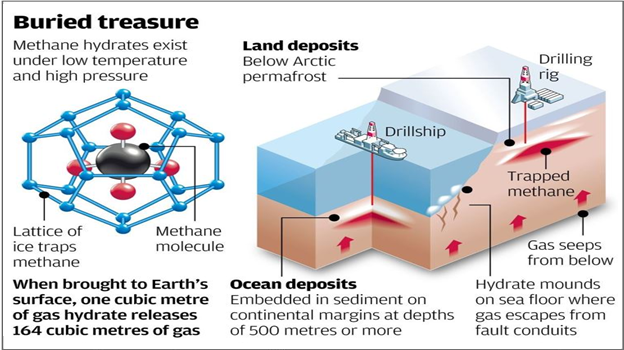Geography
Methane Hydrates in Krishna-Godavari Basin
- 15 Sep 2020
- 5 min read
Why in News
Recently, a study on biogenic methane hydrate in the Krishna-Godavari (KG) Basin was conducted by the researchers at the Agharkar Research Institute (ARI), an autonomous institute of the Department of Science and Technology, Government of India.
Key Points
- Biogenic Methane: It is the methane produced from the metabolic activities of living organisms. The research team has identified the methanogens that produced the biogenic methane trapped as methane hydrate, which can be a significant source of energy.
- Methanogens: These are microorganisms that produce methane as a metabolic by-product in hypoxic (low levels of oxygen) conditions.
- The ARI team has documented a predominance of genus Methanosarcina in the KG basin, followed by a few other genera Methanoculleus, Methanobacterium.
- Methane hydrate is formed when hydrogen-bonded water and methane gas come into contact at high pressures and low temperatures such as in oceans.
- Methanogens: These are microorganisms that produce methane as a metabolic by-product in hypoxic (low levels of oxygen) conditions.
Methane Hydrate
- Methane hydrate is a crystalline solid that consists of a methane molecule surrounded by a cage of interlocking water molecules.
- Methane hydrate is an "ice" that only occurs naturally in subsurface deposits where temperature and pressure conditions are favourable for its formation.
- Difficult to handle: If the ice is removed from this temperature/pressure environment, it becomes unstable. For this reason, methane hydrate deposits are difficult to study and handle.
- They cannot be drilled and cored for study like other subsurface materials because as they are brought to the surface, the pressure is reduced and the temperature rises.
- This causes the ice to melt and the methane to escape.
- Several other names are commonly used for methane hydrate. These include: methane clathrate, hydromethane, methane ice, fire ice, natural gas hydrate, and gas hydrate.
- Most methane hydrate deposits also contain small amounts of other hydrocarbon hydrates. These include propane hydrate and ethane hydrate.
- Significance of the Study:
- Methane is a clean and economical fuel.
- It is estimated that one cubic meter of methane hydrate contains 160-180 cubic meters of methane.
- This study revealed maximum methanogenic diversity in the KG basin, which is one of the prominent reasons to confirm it to be the extreme source of biogenic methane in comparison to the Andaman and Mahanadi basins.
- Even the lowest estimate of methane present in the methane hydrates in the KG Basin is twice that of all fossil fuel reserves available worldwide.
Krishna-Godavari Basin
- An extensive deltaic plain formed by two large east coast rivers, Krishna and Godavari in the state of Andhra Pradesh and the adjoining areas of Bay of Bengal in which these rivers discharge their water is known as Krishna-Godavari Basin.
- The KG Basin is a large basin of continental margin located on the east coast of India.
- Its land part covers an area of 15000 sq. km
- The offshore part covers an area of 25,000 sq. km up to 1000 m isobath.
- The basin contains about 5 km thick sediments with several cycles of deposition, ranging in age from Late Carboniferous to Pleistocene.
- The major geomorphological units of the basin are upland plains, coastal plains, recent flood and delta plains.
- The site is known for the D-6 block with the biggest natural gas reserves in India. The first gas discovery was made in 1983 by ONGC.
- The basin is home to the Olive Ridley Sea Turtle (IUCN Status: Vulnerable).





